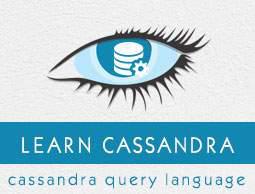Cassandra - Batch Statements
Using Batch Statements
Using BATCH, you can execute multiple modification statements (insert, update, delete) simultaneiously. Its syntax is as follows −
BEGIN BATCH
<insert-stmt>/ <update-stmt>/ <delete-stmt>
APPLY BATCH
Example
Assume there is a table in Cassandra called emp having the following data −
| emp_id |
emp_name |
emp_city |
emp_phone |
emp_sal |
| 1 |
ram |
Hyderabad |
9848022338 |
50000 |
| 2 |
robin |
Delhi |
9848022339 |
50000 |
| 3 |
rahman |
Chennai |
9848022330 |
45000 |
In this example, we will perform the following operations −
- Insert a new row with the following details (4, rajeev, pune, 9848022331, 30000).
- Update the salary of employee with row id 3 to 50000.
- Delete city of the employee with row id 2.
To perform the above operations in one go, use the following BATCH command −
cqlsh:howcodex> BEGIN BATCH
... INSERT INTO emp (emp_id, emp_city, emp_name, emp_phone, emp_sal) values( 4,'Pune','rajeev',9848022331, 30000);
... UPDATE emp SET emp_sal = 50000 WHERE emp_id =3;
... DELETE emp_city FROM emp WHERE emp_id = 2;
... APPLY BATCH;
Verification
After making changes, verify the table using the SELECT statement. It should produce the following output −
cqlsh:howcodex> select * from emp;
emp_id | emp_city | emp_name | emp_phone | emp_sal
--------+-----------+----------+------------+---------
1 | Hyderabad | ram | 9848022338 | 50000
2 | null | robin | 9848022339 | 50000
3 | Chennai | rahman | 9848022330 | 50000
4 | Pune | rajeev | 9848022331 | 30000
(4 rows)
Here you can observe the table with modified data.
Batch Statements using Java API
Batch statements can be written programmatically in a table using the execute() method of Session class. Follow the steps given below to execute multiple statements using batch statement with the help of Java API.
Step1: Create a Cluster Object
Create an instance of Cluster.builder class of com.datastax.driver.core package as shown below.
//Creating Cluster.Builder object
Cluster.Builder builder1 = Cluster.builder();
Add a contact point (IP address of the node) using the addContactPoint() method of Cluster.Builder object. This method returns Cluster.Builder.
//Adding contact point to the Cluster.Builder object
Cluster.Builder builder2 = build.addContactPoint( "127.0.0.1" );
Using the new builder object, create a cluster object. To do so, you have a method called build() in the Cluster.Builder class. Use the following code to create the cluster object −
//Building a cluster
Cluster cluster = builder.build();
You can build the cluster object using a single line of code as shown below.
Cluster cluster = Cluster.builder().addContactPoint("127.0.0.1").build();
Step 2: Create a Session Object
Create an instance of Session object using the connect() method of Cluster class as shown below.
Session session = cluster.connect( );
This method creates a new session and initializes it. If you already have a keyspace, then you can set it to the existing one by passing the KeySpace name in string format to this method as shown below.
Session session = cluster.connect(“ Your keyspace name ”);
Here we are using the KeySpace named tp. Therefore, create the session object as shown below.
Session session = cluster.connect(“tp”);
Step 3: Execute Query
You can execute CQL queries using the execute() method of Session class. Pass the query either in string format or as a Statement class object to the execute() method. Whatever you pass to this method in string format will be executed on the cqlsh.
In this example, we will perform the following operations −
- Insert a new row with the following details (4, rajeev, pune, 9848022331, 30000).
- Update the salary of employee with row id 3 to 50000.
- Delete the city of the employee with row id 2.
You have to store the query in a string variable and pass it to the execute() method as shown below.
String query1 = ” BEGIN BATCH INSERT INTO emp (emp_id, emp_city, emp_name, emp_phone, emp_sal) values( 4,'Pune','rajeev',9848022331, 30000);
UPDATE emp SET emp_sal = 50000 WHERE emp_id =3;
DELETE emp_city FROM emp WHERE emp_id = 2;
APPLY BATCH;”;
Given below is the complete program to execute multiple statements simultaneously on a table in Cassandra using Java API.
import com.datastax.driver.core.Cluster;
import com.datastax.driver.core.Session;
public class Batch {
public static void main(String args[]){
//query
String query =" BEGIN BATCH INSERT INTO emp (emp_id, emp_city,
emp_name, emp_phone, emp_sal) values( 4,'Pune','rajeev',9848022331, 30000);"
+ "UPDATE emp SET emp_sal = 50000 WHERE emp_id =3;"
+ "DELETE emp_city FROM emp WHERE emp_id = 2;"
+ "APPLY BATCH;";
//Creating Cluster object
Cluster cluster = Cluster.builder().addContactPoint("127.0.0.1").build();
//Creating Session object
Session session = cluster.connect("tp");
//Executing the query
session.execute(query);
System.out.println("Changes done");
}
}
Save the above program with the class name followed by .java, browse to the location where it is saved. Compile and execute the program as shown below.
$javac Batch.java
$java Batch
Under normal conditions, it should produce the following output −
Changes done


